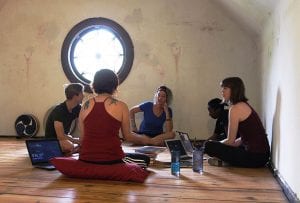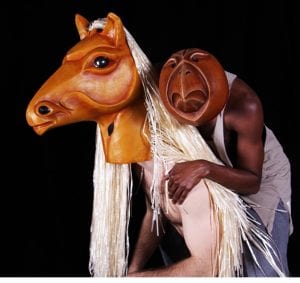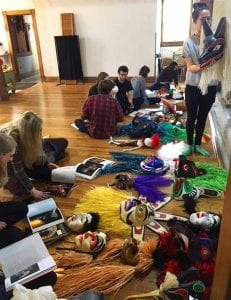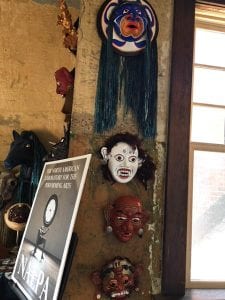Home / Blog Legacy / Theatre Masks and Devising
Theatre Masks and Devising

The Question of Masks in Devising
I was recently speaking with a colleague about a devising workshop that we are planning and he asked me, “why use masks?” This prompted a lot of thought, which led to a lot of questions and then to a lot more thought. Here are some of those thoughts shared.
The question of, “why use masks, can be applied to devising, actor training and performance. The living form of the theatre mask offers the creative artist a deep well of provocations, answers and possible paths to be taken. Our modern world, at least here in the United States, does not have a culture of masked performance nor do we see masks used often in performance. Yet, they still have a place in our creative process and they have a lot to teach us.
Masks designed for performance are incredibly sophisticated rhythmic entities that stand in the world looking out upon it with a singular perspective.
The mask must be brought to life for what it represents as a singular and unique entity.
The imposition of preconceived notions, foreign ideas and superficial judgments while attempting to play the mask will cause it to die, to remain rigid and lifeless.
The mask demands a reach for understanding of something other than the self and a deep understanding of self at the same time. Said in another way, one must have a profound understanding of self in order to bring a mask to life given it is the wearer who must support the mask in its unique singular outlook and in this support, the mask then becomes an extension of self. Herein lies a provocation toward reaching for greater understandings of self and then the application of that toward understanding and partnership of something outside of self.

The theater mask demands a mastery of mechanics and an understanding of form, how to play within that form and how to play a form with the audience in mind. The mask teaches us a refined and definable approach to the understandings of the rhythmic form of character, how emotion manifests in architectural form (physical text), how the form of dramatic structures play, understanding of the specifics of form as concerns the world in which the story takes place (Beckett vs Mamet for example) and how the architectural form of the theater in which the performance takes place must be managed for the audience (proscenium, in the round or thrust…).
The mask requires an understanding of the spaces between. To bring a mask to life the performer must develop an understanding of his or her relationship to the mask while at the same time driving the relationship between the mask and the audience. The mask defines for the actor the meaning of the spaces between much like a musician understands how the space between the notes is where the music lies.
The mask draws our attention to the mechanics of:
- Partnership with the world of the play, the other actors, the dramatic structures inhabited and the audience
- Intention, objectives, the motors that drive the action, the needs and wants
- The body as text, dramatic structures as text, movement as text and special relationships as text
Masks for performance are designed to reveal to us our humanity and draw our attention to the universality of the human experience. They clarify and demand understanding of artistry and practice. The mask for performance is a huge problem to be solved for the actor creator much like the musical instrument is for the musician or the empty canvas is for the painter. The great benefit of the mask is that it is a tangible and allows for a discussion of mechanics and theory that can lead to a process and a practice that is definable for the actor as an interpreter and as a creator of performance.

Using masks to teach devising is also useful because they provoke and inspire story. The masks are all associated with story and character, with ritual and celebration and with politics and philosophy. Masks are connected with the human experience, with the material world and with the ethereal worlds of the beyond. Since the masks are a tangible that we can touch and see specific stories emerge when presented to a student then the question of which story do we tell has already in part been answered when the masks arrive. The stories of the sun and the moon, jealousy and lust, Jupiter and Mercury, Crow and Weasel, the Goddess and the boy or the monkey king and the buffalo skull are all specific in and of themselves. Each of the fore mentioned masks in combination with another allow for a foundation upon which to create. The mask can be a dynamic agent helping to drive the creative process when devising.
One of great problems of devising is the quest for an understanding and or a definition of what makes work successful and accessible. Masks insist on a partnership and a clarification with the self, an audience, the mechanics of performance and creative structures, be they linear, conceptual or poetic. The masks reveal where the successes and the failures present. As a tool for creating, the theater mask can be helpful if the artists involved possess fundamental understandings of the tangibles the masks present.

Attend a workshop, read up on masks in performance, buy a mask and play around. Share your stories with the world at large and through the mask let us bring humanity together.
